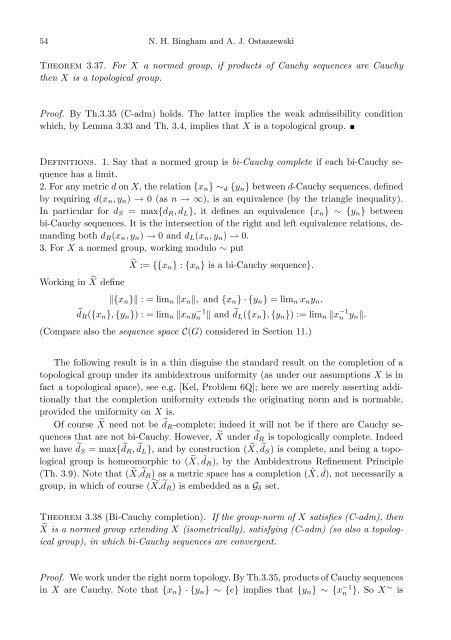Normed versus topological groups: Dichotomy and duality
Normed versus topological groups: Dichotomy and duality
Normed versus topological groups: Dichotomy and duality
Create successful ePaper yourself
Turn your PDF publications into a flip-book with our unique Google optimized e-Paper software.
54 N. H. Bingham <strong>and</strong> A. J. OstaszewskiTheorem 3.37. For X a normed group, if products of Cauchy sequences are Cauchythen X is a <strong>topological</strong> group.Proof. By Th.3.35 (C-adm) holds. The latter implies the weak admissibility conditionwhich, by Lemma 3.33 <strong>and</strong> Th. 3.4, implies that X is a <strong>topological</strong> group.Definitions. 1. Say that a normed group is bi-Cauchy complete if each bi-Cauchy sequencehas a limit.2. For any metric d on X, the relation {x n } ∼ d {y n } between d-Cauchy sequences, definedby requiring d(x n , y n ) → 0 (as n → ∞), is an equivalence (by the triangle inequality).In particular for d S = max{d R , d L }, it defines an equivalence {x n } ∼ {y n } betweenbi-Cauchy sequences. It is the intersection of the right <strong>and</strong> left equivalence relations, dem<strong>and</strong>ingboth d R (x n , y n ) → 0 <strong>and</strong> d L (x n , y n ) → 0.3. For X a normed group, working modulo ∼ putWorking in ˜X define˜X := {{x n } : {x n } is a bi-Cauchy sequence}.‖{x n }‖ : = lim n ‖x n ‖, <strong>and</strong> {x n } · {y n } = lim n x n y n ,˜d R ({x n }, {y n }) : = lim n ‖x n y −1n‖ <strong>and</strong> ˜d L ({x n }, {y n }) := lim n ‖x −1n y n ‖.(Compare also the sequence space C(G) considered in Section 11.)The following result is in a thin disguise the st<strong>and</strong>ard result on the completion of a<strong>topological</strong> group under its ambidextrous uniformity (as under our assumptions X is infact a <strong>topological</strong> space), see e.g. [Kel, Problem 6Q]; here we are merely asserting additionallythat the completion uniformity extends the originating norm <strong>and</strong> is normable,provided the uniformity on X is.Of course ˜X need not be ˜d R -complete; indeed it will not be if there are Cauchy sequencesthat are not bi-Cauchy. However, ˜X under ˜dR is <strong>topological</strong>ly complete. Indeedwe have ˜d S = max{ ˜d R , ˜d L }, <strong>and</strong> by construction ( ˜X, ˜d S ) is complete, <strong>and</strong> being a <strong>topological</strong>group is homeomorphic to ( ˜X, ˜d R ), by the Ambidextrous Refinement Principle(Th. 3.9). Note that ( ˜X, ˜d R ) as a metric space has a completion ( ˆX, ˆd), not necessarily agroup, in which of course (˜X, ˜d R ) is embedded as a G δ set.Theorem 3.38 (Bi-Cauchy completion). If the group-norm of X satisfies (C-adm), then˜X is a normed group extending X (isometrically), satisfying (C-adm) (so also a <strong>topological</strong>group), in which bi-Cauchy sequences are convergent.Proof. We work under the right norm topology. By Th.3.35, products of Cauchy sequencesin X are Cauchy. Note that {x n } · {y n } ∼ {e} implies that {y n } ∼ {x −1n }. So X ∼ is
















